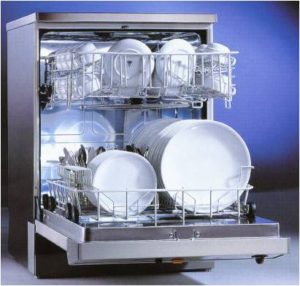We recommend using an enzyme detergent and a rinse aid. Those together with the proper placement of your dishes will produce the best results.
- Large items should be at the sides and back of the dishwasher, so that they don’t block other dishes.

- Place the dirtier side of dishes toward the center of the machine.
- Use the top rack for plastic and delicate items.
- Rest glassware on prongs and make sure pieces do not touch each other to prevent breakage.
- Mix silverware types to prevent them from sticking together & load them handles down (except knives = handles up).
- Place items with baked-on food facedown and toward the sprayer in the bottom rack.
Note: Do not machine-wash anything that is not “Dishwasher Safe” such as brass, bronze, cast iron, disposable plastics, gold-colored flatware, gold-leaf china, hollow-handle knives, pewter, tin, or anything made of wood or with a wood handle.
Run only full loads, & don’t waste time & water by pre-rinsing.

WOW – you think you know…. Dishwashers seem simple enough, but I was surprised to learn. Thanks for making it easy to understand. Everywhere else I looked seemed to be geared more for repair folks or other professionals. I didn’t need full schematics, wiring diagrams, etc. Your post was very helpful.
I have several things to tackle around the house. This & other posts from you are a huge help. Thanks!
I am not real fantastic with English but I come up this very easygoing to translate.
this post saved me a call to the repair person – thanks to you for posting
Very interesting topic, appreciate it for posting.
Excellent read, I just passed this onto a colleague who was doing some research on that. And he actually bought me lunch as I found it for him 🙂 Thus let me rephrase that: Thank you for lunch!
Better than owners manual & easier to read.
This is EXACTLY what I didn’t realize I needed.
😀 Thanks
Say, you got a nice post here 🙂